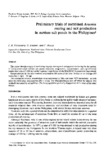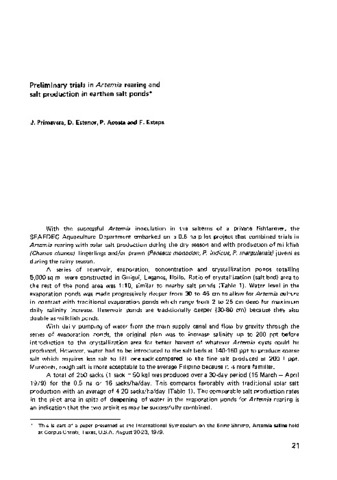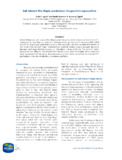Preliminary trials of combined Artemia rearing and salt production in earthen salt ponds in the Philippines
- Global styles
- MLA
- Vancouver
- Elsevier - Harvard
- APA
- Help
Share
Abstract
This paper describes trials at combining Artemia rearing with salt production during the dry season, in newly-constructed earthen salt ponds (reservoir, evaporation, concentration, and crystallization ponds, total area of 5,000 m2 at the Leganes, Iloilo Station of the SEAFDEC Aquaculture Department.
Salt production by the solar method amounted to 250 sacks of slat over 30 days or an average of 8 sacks/day (1 sack = 50 kg).
Two successful Artemia inoculations were undertaken in May and June 1979 respectively : in both cases the adult stage was reached after 1 week. The May population died off when the salinity was suddenly increased by salt addition. The June population gradually disappeared at the onset of the rainy season.
Suggested Citation
Primavera, J. H., Estenor, D., & Acosta, P. (1980). Preliminary trials of combined Artemia rearing and salt production in earthen salt ponds in the Philippines. In G. Persoone, P. Sorgeloos, O. Roels, & E. Jaspers (Eds.), The Brine Shrimp Artemia. Proceedings of the International Symposium on the brine shrimp Artemia salina, Corpus Christi, Texas, USA, August 20-23, 1979. (Vol. 3. Ecology, Culturing, Use in Aquaculture, pp. 207–214). Wetteren, Belgium: Universa Press.
Type
Conference paperKoleksi
- Conference Proceedings [299]
Related items
Showing items related by title, author, creator and subject.
-
Preliminary trials in Artemia rearing and salt production in earthen salt ponds
Primavera, J.; Estenor, D.; Acosta, P.; Estepa, F. (Aquaculture Department, Southeast Asian Fisheries Development Center, 1979)The authors report on the production of Artemia obtained on a 0.5 ha pilot project with combined trials in Artemia rearing with solar salt production during the dry seasons and with production of milkfish (Chanos chanos) ... -
Sulfide-hemoglobin interactions in the sulfide-tolerant salt marsh resident, the California killifish Fundulus parvipinnis
Sulfide can potentially damage hemoglobin or be detoxified by hemoglobin. In the sulfide-tolerant California killifish neither seems to be the case at environmentally realistic (micromolar) and physiologically relevant ... -
Salt tolerant Nile tilapia production: Prospects in aquaculture
In the Philippines, salt tolerant Nile tilapia strains have been developed and promoted for culture to increase tilapia production in brackishwater pond systems previously dedicated for milkfish and/or penaeid shrimp ...






